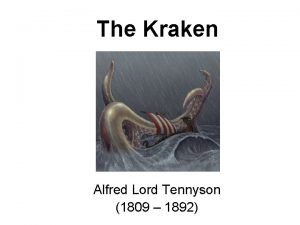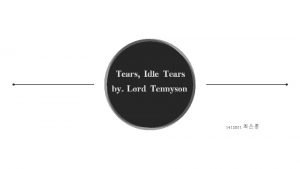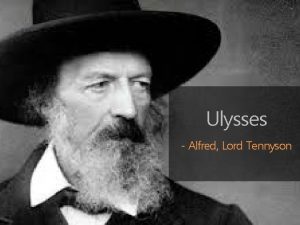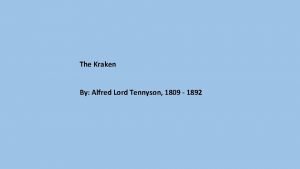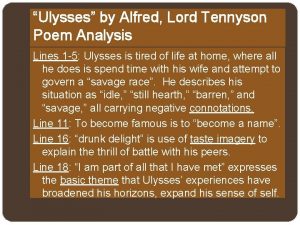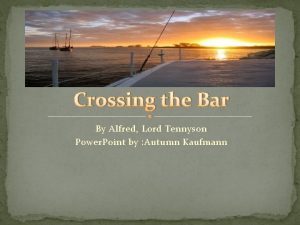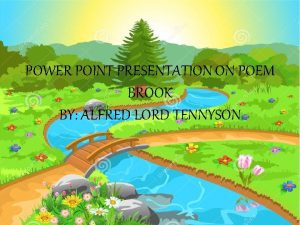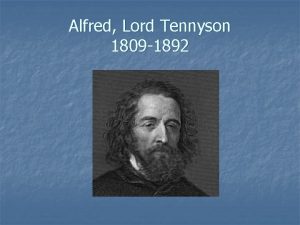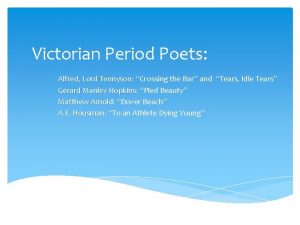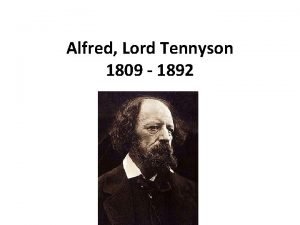TEARS IDLE TEARS v Alfred Lord Tennyson 1809
![“TEARS IDLE TEARS” v Alfred Lord Tennyson [1809 -1892] “TEARS IDLE TEARS” v Alfred Lord Tennyson [1809 -1892]](https://slidetodoc.com/presentation_image_h2/6fb10c5f56623a0f2b548ac3ccb3288d/image-1.jpg)
![ALFRED, LORD TENNYSON [1809 -1892] ALFRED, LORD TENNYSON [1809 -1892]](https://slidetodoc.com/presentation_image_h2/6fb10c5f56623a0f2b548ac3ccb3288d/image-2.jpg)


![FORM • Unrhymed Iambic Pentameter Five line stanzas [Quintet] • Refrain -The days that FORM • Unrhymed Iambic Pentameter Five line stanzas [Quintet] • Refrain -The days that](https://slidetodoc.com/presentation_image_h2/6fb10c5f56623a0f2b548ac3ccb3288d/image-5.jpg)





- Slides: 10
![TEARS IDLE TEARS v Alfred Lord Tennyson 1809 1892 “TEARS IDLE TEARS” v Alfred Lord Tennyson [1809 -1892]](https://slidetodoc.com/presentation_image_h2/6fb10c5f56623a0f2b548ac3ccb3288d/image-1.jpg)
“TEARS IDLE TEARS” v Alfred Lord Tennyson [1809 -1892]
![ALFRED LORD TENNYSON 1809 1892 ALFRED, LORD TENNYSON [1809 -1892]](https://slidetodoc.com/presentation_image_h2/6fb10c5f56623a0f2b548ac3ccb3288d/image-2.jpg)
ALFRED, LORD TENNYSON [1809 -1892]

TENNYSON-THE POET q. Victorian Era British Writer, Novelist, Poet q. Tennyson was the true representative Victorian poet. q. Poet Laureate after Wordsworth in queen Victoria’s reign q. Wordsworth calls him “decidedly the greatest of our living poets. q. Most accomplished poetic artist after Milton. q. Superb musician of words. q. Crossing the bar, Break, Ulysses, The Eagle are his other works. q. Greatest work : In Memoriam-Elegy- Arthur Hallam -1850

THEMES q. Aging q. Acceptance of Mortality q. Regret
![FORM Unrhymed Iambic Pentameter Five line stanzas Quintet Refrain The days that FORM • Unrhymed Iambic Pentameter Five line stanzas [Quintet] • Refrain -The days that](https://slidetodoc.com/presentation_image_h2/6fb10c5f56623a0f2b548ac3ccb3288d/image-5.jpg)
FORM • Unrhymed Iambic Pentameter Five line stanzas [Quintet] • Refrain -The days that are no more [Every stanza ends with these lines]

TEARS IDLE TEARS • Tears, idle tears, • I know not what they mean, • Tears from the depth of some divine despair • Rise in the heart, and gather to the eyes, In looking on the happy autumn-fields, And thinking of the days that are no more • The speaker sings of the baseless and inexplicable tears that rise in his heart and pour forth from his eyes when he looks out on the fields in autumn and thinks of the past. Autumn is often symbolic of a particular era in a human life—that of being past middle age and approaching old age and death.

Fresh as the first beam glittering on a sail, That brings our friends up from the underworld, Sad as the last which reddens over one That sinks with all we love below the verge; So sad, so fresh, the days that are no more. This past, (“the days that are no more”) is described as fresh and strange. It is as fresh as the first beam of sunlight that sparkles on the sail of a boat bringing the dead back from the underworld, and it is sad as the last red beam of sunlight that shines on a boat that carries the dead down to this underworld.

Ah, sad and strange as in dark summer dawns The earliest pipe of half-awakened birds To dying ears, when unto dying eyes The casement slowly grows a glimmering square; So sad, so strange, the days that are no more In the third stanza, nature also seems affected by the speaker’s melancholia, when they are filled with sleepy bird sounds so early in the morning. A person in the midst of the joys of life hears the birds and sees the sunrise with a different spirit than someone who is preoccupied with the lost days. How strange and sad it is for a dying man to hear the first chirp of the birds at the dawn of a summer day and watch the sun turn the window into a “glimmering square. ” But still it’s the past that the speaker is not able to get over.

Dear as remembered kisses after death, And sweet as those by hopeless fancy feigned On lips that are for others; deep as love, Deep as first love, and wild with all regret; O Death in Life, the days that are no more In the final stanza the speaker declares the past to be dear, sweet and wild. It is as dear as the memory of the kisses of one who is now dead and it is as sweet as those kisses that we bestow on other lovers who have loyalties to others. So too, past is as deep as first love and as wild as the regret that usually follows this experience. the poet concludes that past is death in life.

THANKYOU! Prof. Sunita Sinha Head, Department of English Women’s College Samastipur
